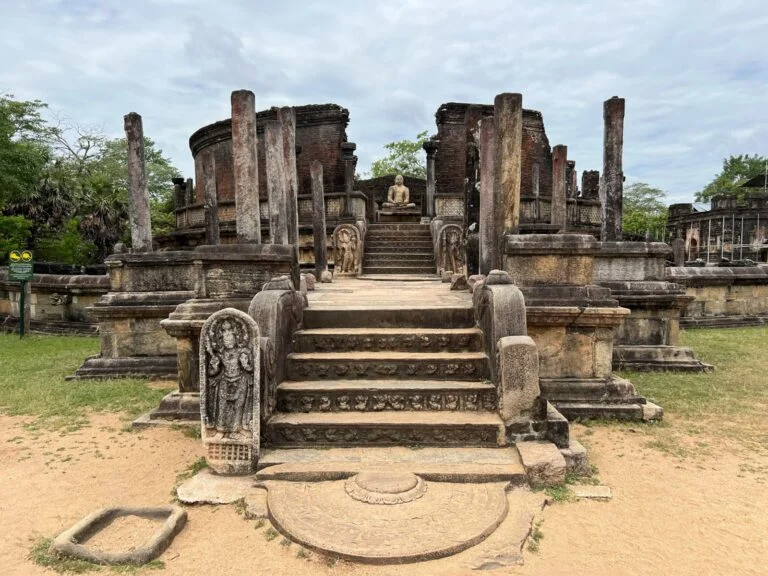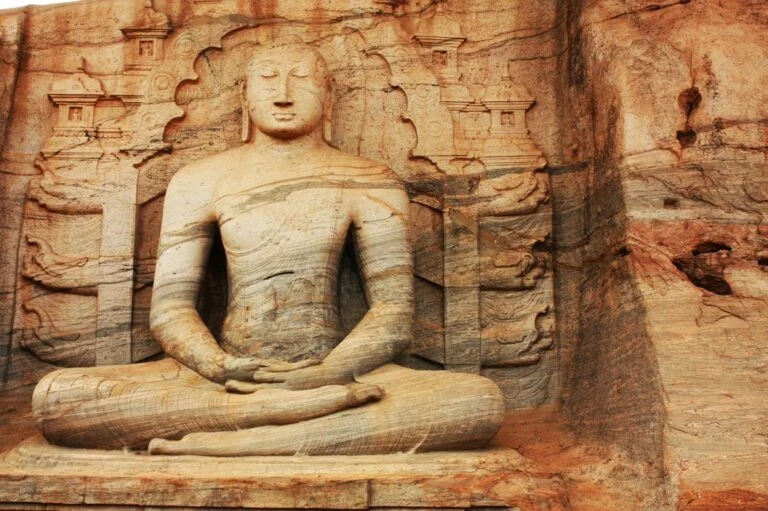Polonnaruwa
- Sri Lanka
Overview
Hello there travellers! In this guide we will be talking about the second major kingdom in Sri Lanka’s history.
That’s right, it’s Polonnaruwa, a city in Sri Lanka with world known tourist spots.In fact, Polonnaruwa is a UNESCO World Heritage site that acts as the capital from the 11th to 13th centuries.
In here, you’ll find some of the most incredible archaeological sites in all of South Asia.
Plus, king Parakramabahu was the mastermind behind this ancient city. And what you’ll see here really shows you just how advanced the Sinhalese civilization and Buddhist culture were back in time.
Anyway, as of this guide, we will be sharing with you five amazing places to visit in here. So without any further explanation let’s get into details.


Highlights
Parakrama Samudra
Parakrama Samudra is also famous as the Sea of Parakrama.
This huge artificial reservoir is honestly mind-blowing when you think about the ancient engineering in it.
Speaking of which, King Parakramabahu built it in the 12th century, and get this – it covers more than 2,500 hectares and still works for irrigation today!
Also, it wasn’t just about storing water; it showed everyone how amazing and advanced the kingdom was in farming.
Anyway, when you visit here, you can take a walk on the massive embankment and take in the beautiful views that are all around.
Plus, if you’re into photography, you must come here during the sunrise or sunset. This is because during this time frame, the water creates these beautiful reflections of the sky.
Which is quite amazing to take a shot at.
Gal Vihara
Gal Vihara is where you’ll see the absolute best of ancient Sri Lankan rock sculptures.
Picture this: Four amazing Buddha statues, all carved from one giant piece of granite rock. Quite amazing right? So, that is what Sri Lankan citizen have done back in time.
However, the most impressive one is this huge reclining Buddha statue that’s 14 meters long. The concept of this statue is to bring out how Buddha enters to Nirvana.
Moreover, there’s this interesting standing Buddha statue that has its arms crossed. In fact, the statue is quite fascinating to see and if you look at it more closely, you will identify the detailing that the statue has.
Speaking of which, some think it shows Buddha deep in thought. While others say it’s actually Ananda Thero who was Buddha’s closest follower by feeling sad about Buddha’s death.
Anyway, as of now, these facts are all left to the historical and religious leaders words.
In addition to that, the seated Buddha statues are special too. Where you can see the hand positions are all mean different things in Buddhist teachings.
On the bright side, what’s really amazing is how amazing is the maintenance at Gal Vihara.
In fact, these carvings have been out in the open for over 800 years, but you can still see all the details in it!
Vatadage
The Vatadage is this really cool circular structure that used to house Buddha’s tooth relic.
It really shows you how amazing the architectural ideas was during the Polonnaruwa period.
In fact, they designed it with four entrances that point to north, south, east, and west, which had special meanings in Buddhist beliefs.
In addition to that, you’ve got to check out the stone doorways and these special semi-circular stones that goes by the name of moonstones at the entrances.
They’re covered in all these detailed carvings of sacred animals and flowers, and each carving has its own special meaning in Buddhism.
Moreover, you can still see the stone pillars that held up the wooden roof, which gives you a good idea of how grand this area used to be.
Speaking of which, this structure was so well-designed that it influenced religious architecture all over Sri Lanka and Southeast Asia.
Therefore, we believe that it’s worth checking out this amazing place.
Lankatilaka
The Lankatilaka temple is a place that is quite hard to miss.
This is because, in here, you can find out massive brick walls that go up 17 meters high! Which is bit rare to see in day to day life.
It’s what they call a gedige-type image house, and it really shows you how amazing the architectural ideas they had in Polonnaruwa.
In fact, they originally built it with an innovative vaulted roof, though nowadays you can only see the walls in here.
Anyway, when you go inside, you can still spot some of the original lime plaster and paint on the walls. That gives you an idea of how beautiful it must have been.
Moreover, there’s a big Buddha statue at the end of the temple, and even though it’s a bit damaged, it’s still impressive to look at.
However, due to this reason, they planned everything really carefully, even by making sure that the light would hit the statue in special ways at different times of the day. In that way, people who would visit there can get a good look at the Lord Buddha statue.
Polonnaruwa Archaeological Museum
Before you explore the ancient city, you should definitely start at the Polonnaruwa Archaeological Museum. This is actually a tip from us to you, to get the perfect travel experience in Polonnaruwa.
In fact, its right near the royal palace complex, and it’s a modern building full of cool stuff that were found during digs around the site.
Speaking of which, the museum really helps you to understand what you’re going to see when you explore the ruins.
In fact, you’ll find all sorts of interesting things here. As in, bronze sculptures, old coins, pottery, and pieces of buildings that tell you about what life was like back then.
However, one of the best parts is seeing the models of what those major buildings used to look like as in it really helps you to picture how amazing the ancient city was.
Moreover, they’ve also got a great collection of carved moonstones, guardstones, and other decorative pieces that show you how artistic people were back then.
As a matter of fact, they’ve made everything really easy to understand with interactive displays and information in different languages.
Plus, it’s air-conditioned, which is really nice when you’re taking a break from exploring in the heat!
Polonnaruwa is definitely one of the most important historical places in Sri Lanka.
From our simple guide, we hope that you are aware of it by now.
In fact, together, we are sure that these places give you a really good picture of how advanced ancient Sri Lankan civilization was.
Therefore, always remember that when you visit Polonnaruwa, you’re not just looking at old ruins. Which means, that you’re connecting with the history that’s still important in Sri Lanka today.
Get a Quote!
Your Expert Partners in
Travel Planning
Planning a vacation should feel exciting—not overwhelming. That’s where we come in. With a deep understanding of destinations, logistics, and what makes a trip truly special, our team of travel professionals handles every detail for you.

